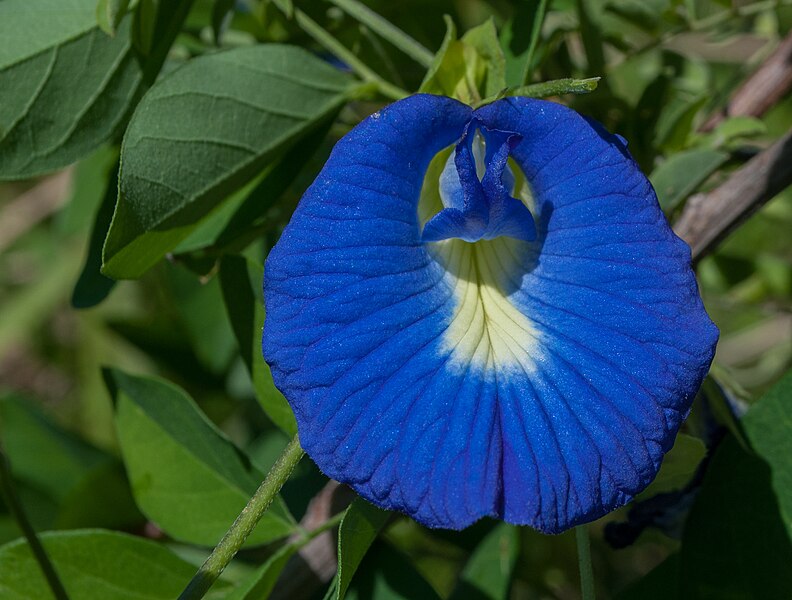Also known as Asian Pigeon Wings, Blue Bell Vine, Blue Pea, Cordofan Pea and Darwin Pea, ‘Butterfly Pea’ (Clitoria ternatea) is an amazing brain boosting herb native to tropical equatorial Asia.
A traditional Chinese and Ayurvedic medicine, Clitoria Ternatea has been consumed for centuries as a memory enhancer, brain booster, anti-stress and calmative agent. Its scientific name is Clitoria Ternatea as the shape of the flower looks strikingly similar to one of the female organs.

I have been drinking an organic butterfly pea flower + lemongrass tea imported from Thailand everyday for the past one year. I seem to get hooked to this tea. The aromatic smell of the lemongrass in vivid blue is indeed a captivating and refreshing non-caffeinated tea to drink everyday.

Once hot water is added to the tea bag, the deep blue liquid changes color based on the pH level of whatever is added next. Squeeze in some lemon or add in a bit of citrus juice, and the blue changes to purple. Its beautiful natural color and health benefits that come along with it have made Blue Pea Flower tea a hit with anyone who enjoys a little whimsy in their life.
Culinary Uses of the Butterfly Pea Flower
It is not only tea that the butterfly pea flower is used for. In Southeast Asia, it is used as a food coloring which is so much healthier than chemically processed colorings. Also, in Malaysia, an extract of the flower is used to color rice in the dishes, Kuih Ketan, and Nyonya chang. In Kelantan, which is in East Malaysia, they add a few buds of the flower while cooking white rice, just to have a bluish tint to the dish.
In Thailand, a syrupy blue drink is made out of the butterfly pea flower, and this is called Nam doc anchan. Sometimes a drop of sweet lime juice is added to give it a more acidic taste. The lime juice turns the drink into a beautiful purple-pink color.
On the other hand, in Burma and Thailand, the flowers are dipped in batter and fried.

Benefits of Butterfly Pea (Clitoria Ternatea):
Improves eyesight
Clitoria Ternatea contains an antioxidant called proanthocyanidin, which increases blood flow to the capillaries of the eyes, useful in treatment of glaucoma, blurred vision, retinal damage or tired eyes.
Improves hair growth
Rich in bioflavonoids, Butterfly Pea can promote hair growth and reduce greying of hair.
Improves skin
Butterfly Pea’s antioxidants stimulate collagen and elastin synthesis, which helps rejuvenate the skin and lessen wrinkles and other signs of ageing.
Aphrodisiac
Butterfly Pea has been traditionally used as an aphrodisiac particularly for women and used to treat menstruation problems or white vaginal discharge (leucorrhoea).

Photo credits – MajesticHerbs.com
Antioxidant
Flavonoids, anthocyanins and phenolic compounds in Butterfly Pea flowers activate antioxidant activity, which helps decrease oxidative stress caused by disease causing and ageing free radicals.
Nootropic
Butterfly Pea has been shown to enhance cognitive function and boost brain function.
Diuretic
Butterfly Pea promotes normal urination, which in turn lowers blood pressure
Analgesic
Clitoria Ternatea has been used traditionally as a local anaesthetic as it has been shown to help relieve pain and swelling.
Anxiolyhic
Butterfly Pea has a calming effect on the body, reducing stress and anxiety
Anti-inflammatory
The deep indigo flowers contain flavonoids. Found in almost all fruits and vegetables, flavonoids are powerful antioxidants with anti-inflammatory and immune system benefits.
Anti-Asthmatic
It is used in common cold, cough & asthma as it acts as an expectorant and reduces the irritation of respiratory organs.
Anti-anxiety and depression
Indications are that high doses of Butterfly Pea may be adaptogenic – helping the body deal with stressors.
Anti-diabetic
Butterfly Pea has shown to inhibit glucose intake from the diet.
Anti-HIV
Butterfly Pea is one of the few herbs to contain cyclotides, which have exhibited anti-HIV effects in studies.
Anti-cancer and anti-tumor
Clitoria Ternatea’s cyclotides can cause cancer cell death by disrupting cell membrane integrity.
Anti-microbial
In several Indian studies, Butterfly Pea exhibited significant anti-microbial effects against Staphylococcus Aureus.
Anti-convulsant
Butterfly Pea has been shown to help reduce the severity and stress on the body from convulsions useful in treating epilepsy.
Anti-pyretic
Clitoria Ternatea can help reduce fever by dilating the blood vessels right beneath the skin, whereby air can cool the blood easier.
